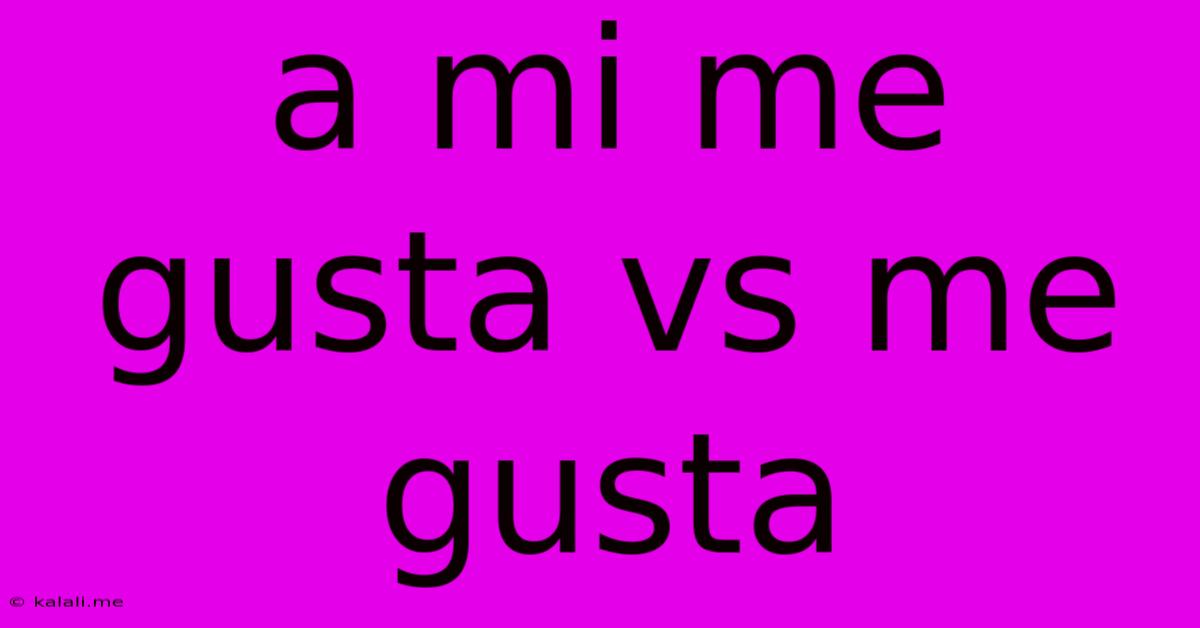A Mi Me Gusta Vs Me Gusta
Kalali
Jun 08, 2025 · 3 min read

Table of Contents
A Mí Me Gusta vs. Me Gusta: Understanding the Subtle Difference in Spanish
This article will delve into the seemingly minor, yet crucial, difference between "a mí me gusta" and "me gusta" in Spanish. While both phrases translate to "I like" in English, understanding their nuances is key to mastering the intricacies of the Spanish language. This subtle distinction hinges on emphasis and context, significantly impacting the overall meaning and natural flow of your sentences.
Understanding the Basic Structure: Me Gusta
The simpler phrase, "me gusta," translates directly to "I like" and is used when expressing a general preference. It's a straightforward and commonly used construction. The verb "gustar" (to be pleasing to) is an impersonal verb, meaning it doesn't directly take a subject pronoun like "I," "you," "he," etc. Instead, the indirect object pronoun reflects the person experiencing the liking.
Example: Me gusta el chocolate. (I like chocolate.)
Adding Emphasis: A Mí Me Gusta
"A mí me gusta" also translates to "I like," but carries a stronger emphasis. The addition of "a mí" (to me) highlights the speaker's personal preference, emphasizing that they specifically like something, perhaps in contrast to others' opinions. This phrase is useful when you want to make your liking more prominent, or when contrasting your opinion with someone else's.
Example: A mí me gusta el chocolate, pero a ella le gusta el helado. (I like chocolate, but she likes ice cream.) Here, "a mí" emphasizes the speaker's preference for chocolate in comparison to the other person's preference.
When to Use Each Phrase:
The choice between "me gusta" and "a mí me gusta" depends largely on the context and the desired emphasis. Here's a breakdown:
-
Use "me gusta" when:
- You're expressing a simple, general preference.
- The context clearly indicates the subject is you.
- There's no need to specifically highlight your preference.
-
Use "a mí me gusta" when:
- You want to emphasize your personal preference.
- You're contrasting your opinion with someone else's.
- You need to make your liking more prominent within the sentence structure.
- The sentence requires more clarity about who is expressing the liking, even if grammatically implied.
Beyond the Basics: Expanding the Sentence
Both phrases can be expanded upon to include more specific details about what is liked and in what context. The addition of adjectives, adverbs, and other grammatical elements can enhance the expression and add further nuance. For example:
Me gusta mucho el café fuerte.(I like strong coffee very much.)A mí me gusta leer libros en la playa.(I like to read books on the beach.)A mí me gusta más el té que el café.(I like tea more than coffee.)
Mastering the Nuances:
While the difference might seem subtle, mastering the use of "me gusta" and "a mí me gusta" is vital for sounding natural and fluent in Spanish. Paying close attention to the context and the desired emphasis will significantly improve your communication skills and comprehension. Practice using both phrases in various sentences to solidify your understanding and improve your overall fluency. Remember, the subtle differences often make the biggest impact on communication!
Latest Posts
Latest Posts
-
Can I Refrigerate Iced Latte Overnight
Jun 08, 2025
-
Why Does Lactose Milk Last Longer
Jun 08, 2025
-
Meaning Of Wearing Heart On Your Sleeve
Jun 08, 2025
-
Apk Root Wont Download On Lenovo Tablet
Jun 08, 2025
-
Access Iphone Remotely From Another Iphone
Jun 08, 2025
Related Post
Thank you for visiting our website which covers about A Mi Me Gusta Vs Me Gusta . We hope the information provided has been useful to you. Feel free to contact us if you have any questions or need further assistance. See you next time and don't miss to bookmark.